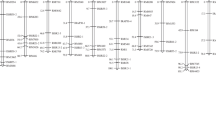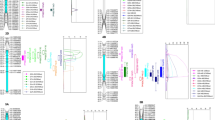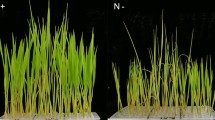Abstract
Aluminium toxicity is adversely affecting the rice growth and production in acidic soils of developing countries. Rice is popular and stable crop which meets food requirements of about 50% world population. A set of 122 rice backcross recombinant inbreed lines (BRILs) derived from a cross between Japonica (cv.02428) and Indica (Changhui/891) was grown in nutrient solution. High density linkage map generated by using 3075 highly stable SNP markers. Relative root length (RRL) was used as standard criteria for aluminium tolerance. A total of 23 QTLs were detected in the current study for six traits across all experimental conditions. Regarding RRL, three QTLs qCRL-6, qSRL-6, and qRRL-6 were found stable and common QTLs across all environments. Out of these three QTLs, qRRL-6 with higher heritability estimates (H2 = 96.59%) was novel QTL with a positive additive effect. In addition, shoot length (SL), shoot fresh weight (SFW), root fresh weight (RFW), shoot dry weight (SDW) and root dry weight (RDW) were used and identified QTLs, qSSL-11, qRRFW-1, and qRRDW-1 and qRRDW-8 which were newly reported QTLs. Three pleiotropic QTLs qRRFW-1, qRSDW-1, and qRRDW-1 were also reported and these QTLs would facilitate to improve Al tolerance by MAS selection and QTLs pyramiding.




Similar content being viewed by others
References
Alia FJ, Shamshuddin J, Fauziah CI, Husni MHA, Panhwar QA (2015) Effects of aluminum, iron and/or low pH on rice seedlings grown in solution culture. Int J Agric Biol 17:702–710. https://doi.org/10.17957/IJAB/14.0019
Anderson PK, Cunningham AA, Patel NG, Morales FJ, Epstein PR, Daszak P (2004) Emerging infectious diseases of plants: pathogen pollution, climate change and agrotechnology drivers. Trends Ecol Evol 19:535–544
Arenhart RA, Schunemann M, Bucker Neto L, Margis R, Wang ZY, Margis-Pinheiro M (2016) Rice ASR1 and ASR5 are complementary transcription factors regulating aluminium responsive genes. Plant Cell Environ 39:645–651
Bian JM, Jiang L, Liu LL, Wei XJ, Xiao YH, Zhang LJ, Zhao ZG, Zhai HQ, Wan JM (2010) Construction of a new set of rice chromosome segment substitution lines and identification of grain weight and related traits QTLs. Breed Sci 60:305–313
Bian J, Zhu G, Zhu C, Peng X, Li C, He X, Chen X, Fu J, Hu L, Ouyang L (2015) Molecular dissection of developmental behavior of tiller number and the relationship with effective panicle using indica–japonica introgression lines in rice. Mol Breed 35:91
Bidhan R, Bhadra S (2014) Effects of toxic levels of aluminium on seedling parameters of rice under hydroponic culture. Rice Sci 21:217–223
Caniato FF, Hamblin MT, Guimaraes CT, Zhang Z, Schaffert RE, Kochian LV, Magalhaes JV (2014) Association mapping provides insights into the origin and the fine structure of the sorghum aluminum tolerance locus, AltSB. PLoS ONE 9:e87438
Chen ZC, Yamaji N, Motoyama R, Nagamura Y, Ma JF (2012) Up-regulation of a magnesium transporter gene OsMGT1 is required for conferring aluminum tolerance in rice. Plant Physiol 159:1624–1633
Da Y, VanRaden PM, Schook LB (2000) Detection and parameter estimation for quantitative trait loci using regression models and multiple markers. Genet Sel Evol 32:357
Deng N, Grassini P, Yang H, Huang J, Cassman KG, Peng S (2019) Closing yield gaps for rice self-sufficiency in China. Nat Commun 10:1–9
Elert E (2014) Rice by the numbers: a good grain. Nature 514:S50–S51
Famoso AN, Clark RT, Shaff JE, Craft E, McCouch SR, Kochian LV (2010) Development of a novel aluminum tolerance phenotyping platform used for comparisons of cereal aluminum tolerance and investigations into rice aluminum tolerance mechanisms. Plant Physiol 153:1678–1691
Famoso AN, Zhao K, Clark RT, Tung C-W, Wright MH, Bustamante C, Kochian LV, McCouch SR (2011) Genetic architecture of aluminum tolerance in rice (Oryza sativa) determined through genome-wide association analysis and QTL mapping. PLoS Genet 7:e1002221
Fujii M, Yokosho K, Yamaji N, Saisho D, Yamane M, Takahashi H, Sato K, Nakazono M, Ma JF (2012) Acquisition of aluminium tolerance by modification of a single gene in barley. Nat Commun 3:1–9
Guimaraes CT, Simoes CC, Pastina MM, Maron LG, Magalhaes JV, Vasconcellos RC, Guimaraes LJ, Lana UG, Tinoco CF, Noda RW, Jardim-Belicuas SN, Kochian LV, Alves VM, Parentoni SN (2014) Genetic dissection of Al tolerance QTLs in the maize genome by high density SNP scan. BMC Genom 15:153
Guo T, Yao P, Zhang Z, Wang J, Wang M (2013) Involvement of antioxidative defense system in rice seedlings exposed to aluminum toxicity and phosphorus deficiency. Chin J Rice Sci 27:653–657
Hosseini M, Houshmand S, Mohamadi S, Tarang A, Khodambashi M, Rahimsoroush H (2012) Detection of QTLs with main, epistatic and QTL × environment interaction effects for rice grain appearance quality traits using two populations of backcross inbred lines (BILs). Field Crops Res 135:97–106
Huang CF, Yamaji N, Chen Z, Ma JF (2012) A tonoplast-localized half‐size ABC transporter is required for internal detoxification of aluminum in rice. Plant J 69:857–867
Huang W, Chen X, Xing C, Zheng Z, Cai M, Zhao X (2013) Effects of phosphorous on aluminum tolerance and cell wall polysaccharide components in rice root tips. Chin J Rice Sci 27:161–167
Jiang N, Shi S, Shi H, Khanzada H, Wassan GM, Zhu C, Peng X, Yu Q, Chen X, He X (2017) Mapping QTL for seed germinability under low temperature using a new high-density genetic map of rice. Front Plant Sci 8:1223
Kochian LV, Pineros MA, Liu J, Magalhaes JV (2015) Plant adaptation to acid soils: the molecular basis for crop aluminum resistance. Annu Rev Plant Biol 66:571–598
Kopittke PM, Menzies NW, Wang P, Blamey FP (2016) Kinetics and nature of aluminium rhizotoxic effects: a review. J Exp Bot 67:4451–4467
Kubo T (1999) Development of a series of Indica chromosome segment substitution lines in Japonica background of rice. Rice Genet Newsl 16:104–106
Li JY, Liu J, Dong D, Jia X, McCouch SR, Kochian LV (2014) Natural variation underlies alterations in Nramp aluminum transporter (NRAT1) expression and function that play a key role in rice aluminum tolerance. PNAS 111:6503–6508
Li CX, Yan JY, Ren JY, Sun L, Xu C, Li GX, Ding ZJ, Zheng SJ (2020) A WRKY transcription factor confers aluminum tolerance via regulation of cell wall modifying genes. J Integr Plant Biol 62:1176–1192
Ma Y, Li C, Ryan PR, Shabala S, You J, Liu J, Liu C, Zhou M (2016) A new allele for aluminium tolerance gene in barley (Hordeum vulgare L.). BMC Genom 17:186
McCouch SR (2008) Gene nomenclature system for rice. Rice 1:72
Meng L, Wang B, Zhao X, Ponce K, Qian Q, Ye G (2017) Association mapping of ferrous, zinc, and aluminum tolerance at the seedling stage in indica rice using MAGIC populations. Front Plant Sci 8:1822
Nguyen V, Burow M, Nguyen H, Le B, Le T, Paterson A (2001) Molecular mapping of genes conferring aluminum tolerance in rice (Oryza sativa L.). Theor Appl Genet 102:1002–1010
Nguyen V, Nguyen B, Sarkarung S, Martinez C, Paterson A, Nguyen H (2002) Mapping of genes controlling aluminum tolerance in rice: comparison of different genetic backgrounds. Mol Genet Genom 267:772–780
Nguyen BD, Brar DS, Bui BC, Nguyen TV, Pham LN, Nguyen HT (2003) Identification and mapping of the QTL for aluminum tolerance introgressed from the new source, Oryza rufipogon Griff., into indica rice (Oryza sativa L.). Theor Appl Genet 106:583–593
Ryan P, Tyerman S, Sasaki T, Furuichi T, Yamamoto Y, Zhang W, Delhaize E (2010) The identification of aluminium-resistance genes provides opportunities for enhancing crop production on acid soils. J Exp Bot 62:9–20
Sade H, Meriga B, Surapu V, Gadi J, Sunita MS, Suravajhala P, Kavi Kishor PB (2016) Toxicity and tolerance of aluminum in plants: tailoring plants to suit to acid soils. Biometals 29:187–210
Satoh T, Tezuka K, Kawamoto T, Matsumoto S, Satoh-Nagasawa N, Ueda K, Sakurai K, Watanabe A, Takahashi H, Akagi H (2016) Identification of QTLs controlling low-temperature germination of the East European rice (Oryza sativa L.) variety Maratteli. Euphytica 207:245–254
Semagn K, Bjørnstad Å, Ndjiondjop M (2006) Principles, requirements and prospects of genetic mapping in plants. Afr J Biotechnol 5(25):2569–2587
Soomro AA, Jian Z (2015) QTL mapping for Aluminum (Al 3) toxicity tolerance in two sets of reciprocal introgression lines in rice (Oryza sativa L.). Int J Sci Res 6:740–748
Tao Y, Niu Y, Wang Y, Chen T, Naveed SA, Zhang J, Xu J, Li Z (2018) Genome-wide association mapping of aluminum toxicity tolerance and fine mapping of a candidate gene for Nrat1 in rice. PLoS ONE 13:e0198589
Visscher PM, Thompson R, Haley CS (1996) Confidence intervals in QTL mapping by bootstrapping. Genetics 143:1013–1020
Wang B, Zhu C, Liu X, Wang W, Ding H, Jiang M, Li G, Liu W, Yao F (2011) Fine mapping of qHD4-1, a QTL controlling the heading date, to a 20.7-kb DNA fragment in rice (Oryza sativa L.). Plant Mol Biol Rep 29:702–713
Wu P, Liao C, Hu B, Yi K, Jin W, Ni J, He C (2000) QTLs and epistasis for aluminum tolerance in rice (Oryza sativa L.) at different seedling stages. Theor Appl Genet 100:1295–1303
Xia J, Yamaji N, Ma JF (2013) A plasma membrane-localized small peptide is involved in rice aluminum tolerance. PlJ 76:345–355
Xue Y, Wan J, Jiang L, Wang C, Liu L, Zhang Y-m, Zhai H (2006) Identification of quantitative trait loci associated with aluminum tolerance in rice (Oryza sativa L.). Euphytica 150:37–45
Xue Y, Jiang L, Su N, Wang JK, Deng P, Ma JF, Zhai HQ, Wan JM (2007) The genetic basic and fine-mapping of a stable quantitative-trait loci for aluminium tolerance in rice. Planta 227:255–262
Yokosho K, Yamaji N, Ma JF (2011) An Al-inducible MATE gene is involved in external detoxification of Al in rice. PlJ 68:1061–1069
Yokosho K, Yamaji N, Fujii-Kashino M, Ma JF (2016) Functional analysis of a MATE gene OsFRDL2 revealed its involvement in Al-induced secretion of citrate, but a lower contribution to Al tolerance in rice. Plant Cell Physiol 57:976–985
Yoshida S, Forno D, Cook J, Gomez K (1976) Laboratory manual for physiological studies of rice, 3rd edn. International Rice Research Institute, Manila
Zhang P, Zhong K, Tong H, Shahid MQ, Li J (2016) Association mapping for aluminum tolerance in a core collection of rice landraces. Front Plant Sci 7:1415
Funding
The research was supported by the National Natural Science Foundation of China (31560350, 31760350 and 7196302), the National Key Research and Development Program of China (2018YFD0301102), the Key Research and Development Program of Jiangxi Province (20171ACF60018 and 20192ACB60003), Natural Science Foundation of Jiangxi (20181BAA208055 and 20202BABL205020) and the Jiangxi Agriculture Research System (JXARS-18).
Author information
Authors and Affiliations
Contributions
AR planned and conducted research work, collected data, prepared manuscript, GMW and HK designed research plan, data analysis and revised the manuscript. AMS helped in data collection, RH and HL helped in some lab work. JB provid backcross Inbred lines and ZW supervised the research.
Corresponding authors
Ethics declarations
Conflict of interest
The authors declare that they have no conflict of interest.
Ethical approval
This article does not contain any studies with human participants or animals performed by any of the authors.
Additional information
Publisher’s note
Springer Nature remains neutral with regard to jurisdictional claims in published maps and institutional affiliations.
Electronic supplementary material
Below is the link to the electronic supplementary material.
Rights and permissions
About this article
Cite this article
Rasheed, A., Wassan, G.M., Khanzada, H. et al. Identification of genomic regions at seedling related traits in response to aluminium toxicity using a new high-density genetic map in rice (Oryza sativa L.). Genet Resour Crop Evol 68, 1889–1903 (2021). https://doi.org/10.1007/s10722-020-01103-2
Received:
Accepted:
Published:
Issue Date:
DOI: https://doi.org/10.1007/s10722-020-01103-2




